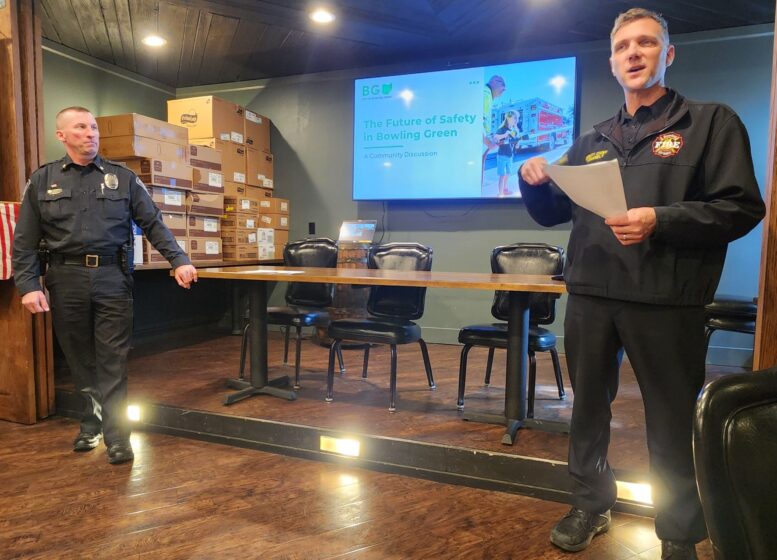By JAN McLAUGHLIN
BG Independent News
Seconds can save lives, prevent serious injuries, and keep fires from becoming flashovers.
As Bowling Green emergency services answer more calls each year, officials are trying to keep response times low, keep services efficient and continue quality care – to provide best chances of survival for people and property.
In order to meet the growing demands on the city’s police and fire divisions, efforts are underway to build two new fire stations and renovate the police department that is housed downtown in a 130-year-old building.
Last week, Police Deputy Chief Justin White and Fire Deputy Chief Tony Zmarzly continued their rounds to community groups to make citizens aware of the city’s plans. On Tuesday, the two spoke to the BG Exchange Club.
“We don’t want to rush this,” White said. “We want to make sure this is something we are talking to the community about.”

Fire Division
Based on current fire station building conditions, the number of emergency calls, and the response times, it has been recommended that the city adopt a three station model for the fire division. The Pearl Street station would be maintained. The Court Street station would be decommissioned. And two new fire stations would be constructed to optimize response times in the city.
Exact locations still haven’t been determined. But the plan calls for a headquarters station on the north side of the city, perhaps in the area of Woodland Mall. Another satellite station would be located on the southeast portion of Bowling Green.
The Court Street fire station has become a problem child for the city. A structural analysis shows problems with the 40-year-old building that sits on an old quarry site that was formerly used as a landfill.
“The structure is sinking,” Zmarzly said.
The station was built at a time when living quarters were only needed for males, and before it was known that housing living quarters above vehicle bays put staff at risk for carcinogens.
And it was constructed when fire apparatus was smaller. Newer vehicles barely squeeze through the bay doors.
“It clears it by inches,” Zmarzly said about the aerial fire truck.
And the Court Street station sits next to the CSX train track through the city. Lessons learned from the East Palestine train derailment suggest that could be a risky location.
The number of emergency calls continue to increase for fire and EMS services. According to Zmarzly, that increase has led to overlapping calls nearly 70% of the time.
In 2024, there were 3,758 calls for fire and EMS – double the number of calls 20 years ago.
With the two existing stations, the fire division is able to meet a goal of four-minute response times in most of the city. That response time is a good industry standard for reaching a patient before irreversible brain damage and a fire before flashover.
But that is getting tougher to achieve with more calls and more simultaneous emergencies, Zmarzly said.
“We’re in a profession where seconds count – and we have time to save minutes,” he said of the new stations plan.
Bowling Green residents and businesses could potentially benefit economically, by insurance rates going down if a lower ISO rating can be achieved.

Police Division
As for the police station, it will remain in the historic building it occupies in the downtown. But it needs extensive renovations in order to meet the needs of the public and police division employees, according to White.
Calls for service have doubled from approximately 15,000 in 1984, to 30,000 in 2024, White said. In that same period, the number of officers has gone from 28 to 42, and the number of dispatchers has grown from nine to 11.
While demands on the police division continue to grow, the space they have to operate in is pretty set in stone. City leaders are determined to keep the station in the downtown, and preserve as much of the exterior as possible on the building constructed in 1893.
While the site is not in question, exactly how to turn it into an efficient and accessible facility is still being worked on. Currently, a parking area takes up much of the police station’s first floor, and a firing range is on the third floor.
The challenge is finding a way to best house a modern policing division in a building more than a century old, White said.
Among the most obvious problems is the public entrance to the station, which requires people to find the elevator or stairway to the second floor where dispatchers are located.
Due to space constraints, some offices are now located in former closets, security measures aren’t as good as they could be, and there is no way to logically locate staff together who work together.
Increased requirements for evidence storage have led the police division to store items in five different locations outside the station.
“We’ve made do,” White said.
The recommendations to the city suggested the following changes to the police station, within its existing footprint: restore historic façade, renovate interior, improve public access and ADA accommodations, address IT and evidence space, and reconfigure to address modern policing.
City officials hope to narrow down potential locations, designs, and devise budgets and financing before coming back to City Council sometime this year. The possibility of a fire levy being considered.

